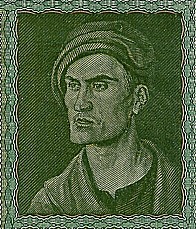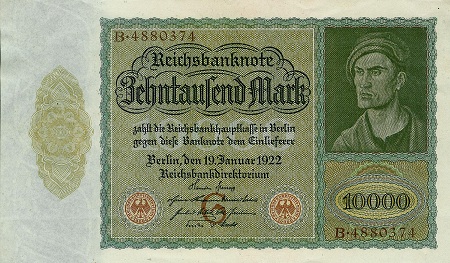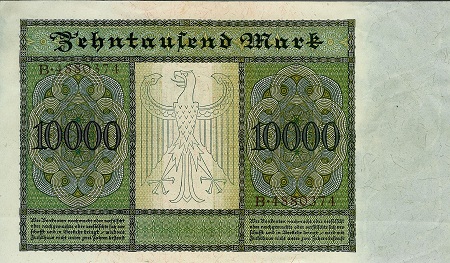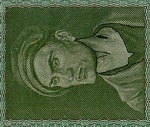GERMANY
“Vampire” Note

In 1922, Germany issued its largest banknote to date – the 10,000 Mark note. This note has three styles; the first has the reverse with the heraldic eagle in rectangular box bounded by ornamental designs, and measures 210x124mm. The second style depicted the reverse with a much simpler monochrome ornamental eagle, and with the same measurements. The third note is the same as the second, but with a smaller dimension of 180x100mm. The front of the note features a painting by Albrecht Durer titled “Portrait of a Young Man” done either in the year1499 or 1500. Albrecht Durer was a very well known painter who created over 1,000 masterpieces.
During WWI the German Mark had begun to lose its value. Germany had increased the financing of the war by going into debt. Having lost the war, Germany was burdened with paying off reparations to several countries by agreement of the Treaty of Versailles. With the reparations and the debts from the failed war, Germany was quickly going into financial crises. The Versailles Treaty demanded that Germany pay 100 Billion Gold Marks immediately, and then to pay 1 Billion Gold Marks annually from 1921 on. Like many other countries before and since, Germany started to print more money. This brought inflation and the specie reserves were quickly vanishing. Printed in January, by August the inflation made the note worthless. It has been estimated that when the note was issued in 1922, 10,000 Marks could buy over 250 pounds of meat. By the end of the year it would buy only 5 pounds of Meat. The Mark was losing value drastically every day.
The German economy was quickly going into a downward spiral with no foreseeable way out. As the treaty was signed n Versailles, there was considerable blame laid upon the French for the economic drain placed on Germany. They felt as is they were being bled dry through the reparations. This banknote depicts this feeling of the German people well. This note depicts the anti French sentiment held by most Germans at the time. Although Durer’s painting “Portrait of a young man” was chosen to be on the banknote, this painting was slightly altered by the engraver at the Reichsdruckeri, who had altered the banknote in the neck of the portrait to depict a rather gothic looking vampire, representing France, which is sucking the life blood out of the throat of Germany through reparations for World War I. It takes a bit of imagination, and a ninety-degree turn of the banknote to the left, to see the hooded vampire, but once spotted, it is readily noticeable from then on. There were three variations of the note yet the altered design of Durer’s portrait was not corrected, showing obvious anti French sentiment held by the Reichsbank at the time.
By January of 1923 the exchange rate was 1 US Dollar to 9,000 Marks. Germany found itself spiraling faster and farther in inflation and was unable to make their reparation payments. In response, Belgian and French troops occupied the Ruhrgebiet region, a primary manufacturing and industrial areas of western Germany. This occupation stifled the German economic ability to the point that its inflation was completely out of hand. By June of 1923, the exchange rate was 1 US Dollar to 100,000 Marks. By August, only two months later, the exchange rate was 1 US Dollar to 4.62 Million Marks.
In November of 1923 Germany took action to halt the rampant inflation by issuing the Rentenmark. 1 Rentenmark was equal to 1,000,000,000,000 Marks.


